 W
WHomelessness is lacking stable and appropriate housing. People can be categorized as homeless if they are: living on the streets ; moving between temporary shelters, including houses of friends, family and emergency accommodation ; living in private boarding houses without a private bathroom or security of tenure. The legal definition of homeless varies from country to country, or among different jurisdictions in the same country or region. United States government homeless enumeration studies also include people who sleep in a public or private place not designed for use as a regular sleeping accommodation for human beings. People who are homeless are most often unable to acquire and maintain regular, safe, secure and adequate housing due to income that is inconsistent or lacking altogether. Homelessness and poverty are interrelated. There is no methodological consensus on counting homeless people and identifying their needs; therefore in most cities only estimated homeless populations are known.
 W
W66 Months: Under the Radar is a 2011 British documentary film directed by James Bluemel focusing on a homeless Nigel Fletcher surviving 6 years without government assistance. It was produced by Moving Target Films in association with Dartmouth Films and was first shown in 2011.
 W
WOn 3 November 2019, Daman Collector Rakesh Minhas issued a Section 144 order banning peaceful assembly of four or more persons, slogan-shouting and the use of loudspeakers across the entire district of Daman and ordered the conversion of Government High School, Bhimpore and the Government Sarvottam High School, Moti Daman into 'temporary jails'. This was in response to a land ownership dispute between the local indigenous fishing community and the local administration that had confiscated their land and bulldozed their homes. The ensuing protest resulted with the detention of 70 protesters in the 'temporary jails' and another 8 arrests. Few of the adivasi fisherfolk were rehoused whilst most languished traumatised and homeless on the streets near the rubble of their razed homes.
 W
WArgyle Street was a Victorian terraced street in Norwich, Norfolk. It became a squat lasting from 1979 to 1985. The street was then demolished in 1986. Some of the newbuild houses were subsequently demolished in 2015.
 W
WThe Banyan is a non-governmental organization based in Chennai, India was founded in 1993 by Vandana Gopikumar and Vaishnavi Jayakumar to cater to the mentally ill and homeless women in the city.
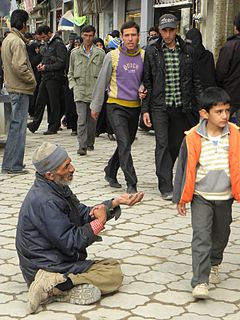 W
WBegging is the practice of imploring others to grant a favor, often a gift of money, with little or no expectation of reciprocation. A person doing such is called a beggar or panhandler. Beggars may operate in public places such as transport routes, urban parks, and markets. Besides money, they may also ask for food, drinks, cigarettes or other small items.
 W
WBergie is a term used for a subsection of homeless people in Cape Town, South Africa. The word originates from the Afrikaans berg meaning "mountain" – the term originally referred to the homeless people who sheltered in the forests of the slopes of Table Mountain. The synonymous term stroller typically refers to street children living a bergie lifestyle.
 W
WBlanchet House is a non-profit social services organization located in Portland, Oregon providing meals, transitional housing, drug and alcohol recovery programs, and support services to those struggling with homelessness and addiction. As a House of Hospitality, Blanchet House welcomes everyone to enjoy hot meals without question six days a week, three times a day. Founded in 1952, by a group of University of Portland students encouraged by their priest to "get out in the streets and help."
 W
WThe Camden bench is a type of concrete street furniture. It was commissioned by the Camden London Borough Council and installed in Camden, London, in 2012. It is designed specifically to influence the behaviour of the public by restricting undesirable behaviour and instead be usable only as a bench, a principle known as hostile architecture. Because the design is "defined far more by what it is not than what it is", the bench has been called the "perfect anti-object" and a "masterpiece of unpleasant design". Other recent names have included 'defensive' or 'disciplinary' architecture. These terms describe many sculptures which are designed and attached or installed in public spaces, in an attempt to render them unusable in certain ways by certain people or groups.
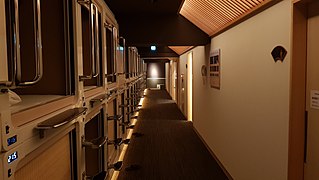 W
WA capsule hotel, also known in the Western world as a pod hotel, is a type of hotel developed in Japan that features many small bed-sized rooms known as capsules. Capsule hotels provide cheap, basic overnight accommodation for guests who do not require or who cannot afford larger, more expensive rooms offered by more conventional hotels.
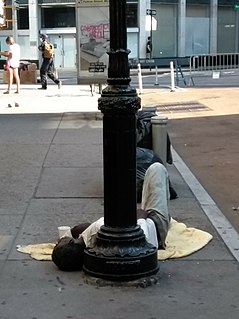 W
WHomeless individuals are more likely to contract COVID-19 than those with permanent housing access. This is due to the environments that homeless people live in, which often suffer overcrowding and/or a lack of access to adequate sanitation. Homeless individuals are also more likely to suffer underlying health conditions, which increases the risk of death caused by COVID-19. The closure of public facilities has negatively impacted the homeless population, as reduced access to toilet facilities and support services has affected their hygiene and mental health respectively. Initiatives have been introduced by governments and at local levels in attempts to reduce the impact on the homeless.
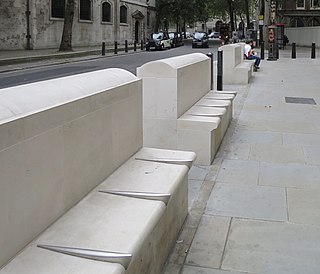 W
WDiscrimination against homeless people is the act of treating homeless people, or people perceived to be homeless, unfavourably. As with most types of discrimination, it can manifest in numerous forms.
 W
WA drop-in center is a service agency for either the mentally ill, homeless people, teenagers, and other communities that offers a place where people can go to obtain food and other services. A mental health drop-in center can provide a friendly environment for people who are struggling with mental health symptoms to recover. Also in another case, a drop-in center as opposed to a homeless shelter usually does not provide a temporary residence; rather, it aims to provide other services to endangered or disadvantaged groups in the community, including the homeless, people with addictions, or teenagers. Drop-in centers are usually open during the daytime. Some regular drop-in centers double as warming centers or cooling centers in the winter or summer, and may provide overnight shelter during these months. Many drop-in centers provide free services, and some offer services for a nominal fee.
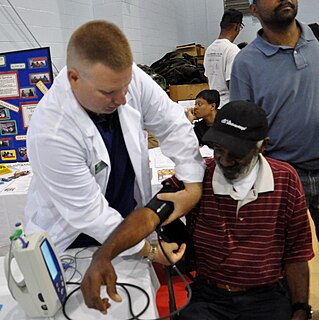 W
WPatient dumping or homeless dumping is the practice of hospitals and emergency services inappropriately releasing homeless or indigent patients to public hospitals or on the streets instead of placing them with a homeless shelter or retaining them, especially when they may require expensive medical care with minimal government reimbursement from Medicaid or Medicare. The term homeless dumping has been used since the late 19th century and resurfaced throughout the 20th century alongside legislation and policy changes aimed at addressing the issue. Studies of the issue have indicated mixed results from the United States' policy interventions and have proposed varying ideas to remedy the problem.
 W
WFamily homelessness refers to a family unit(often blood related) who do not have access to long term accommodation due to various circumstances such as socioeconomic status, access to resources and relationship breakdowns. In some Western countries, such as the United States, family homelessness is a new form of poverty, and a fast growing group of the homelessness population. Some American researchers argue that family homelessness is the inevitable result of imbalanced “low-income housing ratio” where there are more low-income households than there are low-cost housing units. A study in 2018 projected a total of 56,342 family households were recognized as homeless. Roughly 16,390 of these people were living in a place not meant for human habitation. It is believed that homeless families make up about a third of the United States’ population, with generally women being the lead of the household.
 W
WA flophouse or dosshouse is considered a derogatory term for a place that offers very low cost lodging, providing space to sleep and minimal amenities.
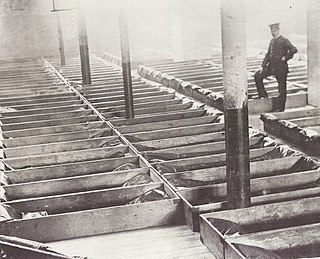 W
WThe four penny coffin or coffin house was one of the first homeless shelters created for the people of central London. It was operated by the Salvation Army during the late 19th and early 20th centuries to provide comfort and aid to its destitute clients.
 W
WA halfway house is an institute for people with criminal backgrounds or drug abuse tendencies to learn the necessary skills to re-integrate into society and better support and care for themselves.
 W
WThe Homeless International Flag, often referred to The Homeless Flag or just Homeless Flag, is a pictogram symbolizing poverty, homelessness, and equality. While the use of the symbol is mainly used in Sweden where it was created, it is also used by people in Canada, Iran, the United States, and Finland.
 W
WIn a study in Western societies, homeless people have a higher prevalence of mental illness when compared to the general population. They also are more likely to suffer from alcoholism and drug dependency. It is estimated that 20–25% of homeless people, compared with 6% of the non-homeless, have severe mental illness. Others estimate that up to one-third of the homeless suffer from mental illness. In January 2015, the most extensive survey ever undertaken found 564,708 people were homeless on a given night in the United States. Depending on the age group in question, and how homelessness is defined, the consensus estimate as of 2014 was that, at minimum, 25% of the American homeless—140,000 individuals—were seriously mentally ill at any given point in time. 45% percent of the homeless—250,000 individuals—had any mental illness. More would be labeled homeless if these were annual counts rather than point-in-time counts. eing chronically homeless also means that people with mental illnesses are more likely to experience catastrophic health crises requiring medical intervention or resulting in institutionalization within the criminal justice system.
 W
WHostile architecture is an urban-design strategy that uses elements of the built environment to purposefully guide or restrict behaviour. It often targets people who use or rely on public space more than others, such as youth, poor people, and homeless people, by restricting the physical behaviours they can engage in.
 W
WThe International Year of Shelter for the Homeless (IYSH) was recognized in 1987 by the United Nations. It was first declared, in principle, in UN resolution 36/71 in 1981, and proclaimed officially in 1982 in resolution 37/221. It was mainly aimed at improving shelter / housing for the poor in general, especially in developing countries. It was also a follow-up to the Habitat I conference in 1976.
 W
WThe Jungle is a greenbelt on the western slope of Beacon Hill in Seattle that is known for its homeless encampments and crime. The Jungle consists of more than 160 acres (65 ha) underneath and along an elevated section of Interstate 5 between South Dearborn Street and South Lucile Street. An assessment counted 201 tents and estimate of more than 400 people in the area prior to a shooting on January 26, 2016, that increased scrutiny and a sweep of the greenspace. The area continues to be used by the homeless as of 2021.
 W
WThe U.S. city of Minneapolis featured officially and unofficially designated camp sites in city parks for people experiencing homelessness that operated from June 10, 2020, to January 7, 2021. The emergence of encampments on public property in Minneapolis was the result of pervasive homelessness, mitigations measures related to the COVID-19 pandemic in Minnesota, local unrest after the murder of George Floyd, and local policies that permitted encampments. At its peak in the summer of 2020, there were thousands of people camping at dozens of park sites across the city. Many of the encampment residents came from outside of Minneapolis to live in the parks. By the end of the permit experiment, four people had died in the city's park encampments, including the city's first homicide victim of 2021, who was stabbed to death inside a tent at Minnehaha Park on January 3, 2021.
 W
WNet café refugees , also known as cyber-homeless , are a class of homeless people in Japan who do not own or rent a residence and sleep in 24-hour Internet cafés or manga cafés. Although such cafés originally provided only Internet services, some have expanded their services to include food, drink, and showers. The term was coined in 2007 by a Nippon News Network documentary show NNN Document. The net café refugee trend has seen large numbers of people using them as their homes. The shifting definition of the industry partly reflects the dark side of Japanese economy, whose precarity has been noted since the downfall of the national economy that has lasted for decades.
 W
WIn law, no fixed abode or without fixed abode is not having a fixed geographical location as a residence, commonly referred to as no fixed address. This is applicable to several groups:People who have a home, but which is not always in the same place: Those whose occupation requires them to live permanently on boats, ships or movable oil platforms, or to travel constantly. Nomadic peoples and traveller groups ; as well as individuals who adopt a mobile lifestyle, living in narrowboats, recreational vehicles or the like. People with multiple residences who frequently move around these addresses. Persons who temporarily live with people such as friends and family. People considered to be homeless. The term "of no fixed abode" or "no fixed address" is frequently used as a description by the police and a euphemism by the media for somebody who is without a home. People may be homeless because of some natural disaster or conflict, which may have destroyed their home. Refugees fleeing a war zone are also regarded as homeless.
 W
WPavement dwellers refers to informal housing built on the footpaths/pavements of city streets. The structures use the walls or fences which separate properties from the pavement and street outside. Materials include cloth, corrugated iron, cardboard, wood, plastic, and sometimes also bricks or cement.
 W
WPost-traumatic stress disorder (PTSD) is a mental and behavioral disorder that can develop because of exposure to a traumatic event, such as sexual assault, warfare, traffic collisions, child abuse, domestic violence or other threats on a person's life. Symptoms may include disturbing thoughts, feelings, or dreams related to the events, mental or physical distress to trauma-related cues, attempts to avoid trauma-related cues, alterations in the way a person thinks and feels, and an increase in the fight-or-flight response. These symptoms last for more than a month after the event. Young children are less likely to show distress, but instead may express their memories through play. A person with PTSD is at a higher risk of suicide and intentional self-harm.
 W
WA shanty town or squatter area is a settlement of improvised buildings known as shanties or shacks, typically made of materials such as mud and wood. A typical shanty town is squatted and in the beginning lacks adequate infrastructure, including proper sanitation, safe water supply, electricity and street drainage. Over time, shanty towns can develop their infrastructure and even change into middle class neighbourhoods. They can be small informal settlements or they can house millions of people.
 W
WHomeless shelters are a type of homeless service agency which provide temporary residence for homeless individuals and families. Shelters exist to provide residents with safety and protection from exposure to the weather while simultaneously reducing the environmental impact on the community. They are similar to, but distinguishable from, various types of emergency shelters, which are typically operated for specific circumstances and populations—fleeing natural disasters or abusive social circumstances. Extreme weather conditions create problems similar to disaster management scenarios, and are handled with warming centers, which typically operate for short durations during adverse weather.
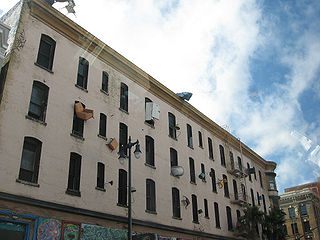 W
WSingle room occupancy is a form of housing that is typically aimed at residents with low or minimal incomes who rent small, furnished single rooms with a bed, chair, and sometimes a small desk. SRO units are rented out as permanent residence and/or primary residence to individuals, within a multi-tenant building where tenants share a kitchen, toilets or bathrooms. SRO units range from 7 to 13 square metres. In the 2010s, some SRO units may have a small refrigerator, microwave and sink.
 W
WSquatting is the action of occupying an abandoned or unoccupied area of land or a building, usually residential, that the squatter does not own, rent or otherwise have lawful permission to use. The United Nations estimated in 2003 that there were one billion slum residents and squatters globally. Squatting occurs worldwide and tends to occur when people who are poor and homeless find empty buildings or land to occupy for housing. It has a long history, broken down by country below.
 W
WA squeegee man or squeegee woman, squeegee kid (Canada), squeegee boy (Baltimore), squeegee punk (Montreal), squeegee merchant (London), squeegee guy or squeegee bandit is a person who, using a washcloth and squeegee, wipes windshields of cars stopped in traffic, in exchange for money.
 W
WStreet children are poor or homeless children who live on the streets of a city, town, or village. Homeless youth are often called street kids or street child; the definition of street children is contested, but many practitioners and policymakers use UNICEF's concept of boys and girls, aged under 18 years, for whom "the street" has become home and/or their source of livelihood, and who are inadequately protected or supervised. Street girls are sometimes called gamines, a term that is also used for Colombian street children of either sex.
 W
WStreet newspapers are newspapers or magazines sold by homeless or poor individuals and produced mainly to support these populations. Most such newspapers primarily provide coverage about homelessness and poverty-related issues, and seek to strengthen social networks within homeless communities. Street papers aim to give these individuals both employment opportunities and a voice in their community. In addition to being sold by homeless individuals, many of these papers are partially produced and written by them.
 W
WA tent city is a temporary housing facility made using tents or other temporary structures.
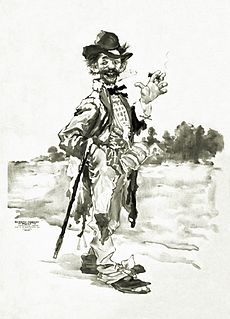 W
WA tramp is a long-term homeless person who travels from place to place as a vagrant, traditionally walking all year round.
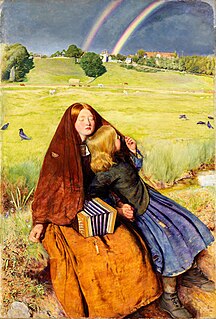 W
WVagrancy is the condition of homelessness without regular employment or income. Vagrants usually live in poverty and support themselves by begging, scavenging, petty theft, temporary work, or welfare. Historically, vagrancy in Western societies was associated with petty crime, begging and lawlessness, and punishable by law with forced labor, military service, imprisonment, or confinement to dedicated labor houses.
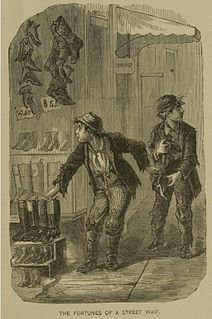 W
WA waif is a living creature removed, by hardship, loss or other helpless circumstance, from its original surroundings. The most common usage of the word is to designate a homeless, forsaken or orphaned child, or someone whose appearance is evocative of the same.
 W
WA warming center is a short-term emergency shelter that operates when temperatures or a combination of precipitation, wind chill, wind and temperature become dangerously inclement. Their paramount purpose is the prevention of death and injury from exposure to the elements. This may include acute trauma from falling objects such as trees, or injury to extremities due to frostbite. A more prevalent emergency which warming centers seek to prevent is hypothermia, the risk for which is aggravated by factors such as age, alcohol consumption, and homelessness.
 W
WYouth homelessness is the problem of homelessness of young people around the globe.